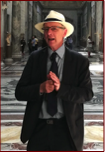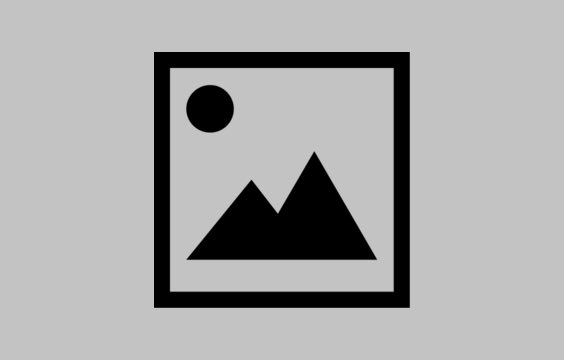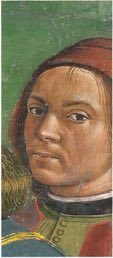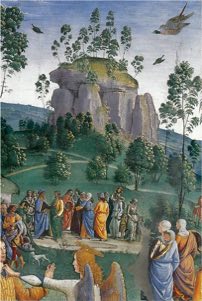Dr. Utr. Iur.
Frank
Van den Broeke

To book an authorised guided tour with me: .... Click here
Wine & Dine: ... Click here
Where to buy your tickets ... ? Click here
Walls of Sistine Chapel
Moses Leaving Egypt - Baptism of Christ
The two works of Perugino seams to be reversed mirrors to each other: looking at the centre figures of the works, it seems an opposite action. The Old Testament action takes place in front of an erected arid mountain: Moses is pushed back by an angel (representing JHWH), because before leaving: he didn’t fulfilled the old Covenant between God and his People: The act of circumcision of his youngest son in the right corner. His father in law would do it for him. That act produced the reconciliation between Moses and the Lord. But his original disobedience will have consequences. He will not enter the promised country.
How different is the scene of the baptism. Almost in a caressing way saint John the Baptist holds his hand with the bowl of water, blessed directly by God and the Holy Spirit, over the head of Jesus. Entering in the new Covenant is not any longer through bled, but through the spirit of the Holy Water. The healed leper does what the law of Moses describes him to do: But now he washes himself in the Blessed water of the new Covenant. His white cloak expresses that his faith in the Son of God healed him. His faith made a turning point in his life.
Also the location is important: it’s a point of (no) return: The root of the verb “to turn” in Hebrew לַהֲפוֹך means: reverse, turn, convert, change, invert, go! The same word used for to confess is the one used for to baptize. And today the Sistene chapel is still used by the Holy Father to baptize. All in front of the image of Him who didn’t need it.
Why was chosen the Jordan? Yes indeed: a sweet water river ends in the Dead Sea with salt water. Fish would come down to that point were sweet and salt are meeting each other. But then turning away from the dead water in their choice for Living water. Biblically, that turning point is considered as the place were the Son of God was baptized.
As Pope Benedict XVI said in his homily on January 10, 2010 on the feast of the Baptism in the Sistine Chapel when he baptized new children in the Congregation of the Faithful: “We find him with John the Baptist to whom multitudes have flocked, in an unusual scene. In the Gospel passage that has just been proclaimed St Luke remarks first of all that the people "were in expectation" (3: 15). In this way he emphasizes the expectation of Israel and, in those people who had left their homes and their usual tasks, the profound desire for a different world.
The baptism John offers is one of repentance, a sign that is an invitation to conversion, to a change of life, because One is coming who will "baptize with the Holy Spirit and with fire" (3: 16). Indeed it is impossible to aspire to a new world while remaining immersed in selfishness and habits linked to sin. Jesus too leaves his home and his customary occupations to go to the Jordan”
In both works of Perugino “they” are expecting a new world: The Israelites want to turn away from the slavery of Egypt (that had a certain commodity, if you hear their often complaints in the desert).... and the followers of Christ turn away from sin.
At the close of the Patristic era, the Venerable Bede (673-735) composed a classic homily "On the Feast Day of the Lord's Circumcision." His premise is, of course, solidly Augustinian. "You ought to know," he writes, "that circumcision under the law wrought the same healing against the wound of original sin as does baptism in this time of revealed grace, except that under circumcision they were not able to enter the gate of the heavenly kingdom. . . .',1 But Bede proceeds to draw an important conclusion. So long as circumcision was chiefly a token of initiation into Abraham's covenant, Christ had need of it to qualify as a true son of Abraham.
But insofar as circumcision cancels Original Sin, from which Christ is exempt, he needed it not. A logical consequence never to be forgotten: the Son of God, says Bede, "submitted to circumcision as decreed by the law. . . . He who was without any stain of pollution . . did not reject the remedy by which the flesh of sin is made clean." Why, then, did he submit? Firstly, says Bede, "that he might commend to us the necessary virtue of obedience by an outstanding example. . . . Likewise also he submitted himself to the waters of baptism, by which he wished the people to be washed clean of the filth of sin . . . undergoing it himself, not from necessity, but . . . to set an example. . . . Purification, both by the law and by the gospel, none of which he stood in need of, the Lord did not despise and did not hesitate to undergo." (In die festo circumcisionis domini, cols. 54A, 55A)
In Christ and his baptism we have to change (turn) not physically/painful anymore, but spiritually/in love: in our hearts! Therefore Baptism is indeed a Spiritual circumcision.
The three buildings in the background express the same feelings: The arch of Constantine, the first emperor to convert and embrace christianity. The Pantheon as first pagan temple that became a Roman Catholic Church in Rome on the 13th May 609, dedicated to the Martyrs of the Colosseum. Martyrs, who by their faith turned away from slavery (like the Israelites) to testimony their faith in the Living God.
For all of us it is a turn: to the Promised Country for the one, to eternal Paradise for the other. But the Hebrew verb “to turn” means also “to go!” Once the old Covenant was made, the Israelites were ready to go. The new Covenant in the Baptism of Jesus tells us “to go!”: a new start, becoming testimonials of a new Evangelization.
But before, let’s “turn” our eyes to those beautiful works of Perugino and take your time as many artist did before, for meditating the biblical texts.
★ Reflexion on “Moses leaving Egypt” and the “Baptism of Christ”
★ Biblical description: Moses leaving Egypt (Perugino)
★ Biblical description of the Baptism of Jesus (Perugino)
★ Centre on the river Jordan: the cleansing of the healed leper
40 A man suffering from a virulent skin-disease came to him and pleaded on his knees saying, 'If you are willing, you can cleanse me.'41 Feeling sorry for him, Jesus stretched out his hand, touched him and said to him, 'I am willing. Be cleansed.'42 And at once the skin-disease left him and he was cleansed.43 And at once Jesus sternly sent him away and said to him,44 'Mind you tell no one anything, but go and show yourself to the priest, and make the offering for your cleansing prescribed by Moses as evidence to them.'
Perugino
1483-5
Observatio antique regenerationis a Moise per circoncisionem
Pietro Perugino
1481-3
Institutio novae regenerationis a Christo in Baptismo
Pietro Perugino
1481-3


Perugino


★ Biblical description: Moses leaving Egypt
✤ In the back left: After meeting JHWH in the burning bush, Moses returns to Egypt.
18 Moses went back to his father-in-law Jethro and said to him, 'Give me leave to return to my kinsmen in Egypt and see if they are still alive.' And Jethro said to Moses, 'Go in peace.'19 Yahweh said to Moses in Midian, 'Go, return to Egypt, for all those who wanted to kill you are dead.'20 So Moses took his wife and his son and, putting them on a donkey, started back for Egypt; and Moses took the staff of God in his hand.
✤ In the middle front: Moses is stopped by an Angel with authoritative gesture -because
24 On the journey, when he had halted for the night, Yahweh encountered him and tried to kill him.25 Then Zipporah, taking up a flint, cut off her son's foreskin and with it touched his feet and said, 'You are my blood-bridegroom!'26 So he let him go. She said, 'Blood-bridegroom' then, with reference to the circumcision.
✤ Right front: Moses can only leave for Egypt after his youngest son Eliezer has circumcised. Man on the very right who is looking at us is Perugino himself.
✤ In the middle back: Moses bidding farewell to Jethro, his father in law ... to go on the journey to the promised country.
18 Moses went back to his father-in-law Jethro and said to him, 'Give me leave to return to my kinsmen in Egypt and see if they are still alive.' And Jethro said to Moses, 'Go in peace.'19 Yahweh said to Moses in Midian, 'Go, return to Egypt, for all those who wanted to kill you are dead.'
★ Biblical description of the Baptism of Jesus
★ Left back: Sermon of St. John the Baptist
1 In due course John the Baptist appeared; he proclaimed this message in the desert of Judaea,2 'Repent, for the kingdom of Heaven is close at hand.'3 This was the man spoken of by the prophet Isaiah when he said: A voice of one that cries in the desert, 'Prepare a way for the Lord, make his paths straight.'4 This man John wore a garment made of camel-hair with a leather loin-cloth round his waist, and his food was locusts and wild honey.5 Then Jerusalem and all Judaea and the whole Jordan district made their way to him,6 and as they were baptized by him in the river Jordan they confessed their sins.7 But when he saw a number of Pharisees and Sadducees coming for baptism he said to them, 'Brood of vipers, who warned you to flee from the coming retribution?8 Produce fruit in keeping with repentance,9 and do not presume to tell yourselves, "We have Abraham as our father," because, I tell you, God can raise children for Abraham from these stones.10 Even now the axe is being laid to the root of the trees, so that any tree failing to produce good fruit will be cut down and thrown on the fire.11 I baptise you in water for repentance, but the one who comes after me is more powerful than I, and I am not fit to carry his sandals; he will baptise you with the Holy Spirit and fire.12 His winnowing-fan is in his hand; he will clear his threshing-floor and gather his wheat into his barn; but the chaff he will burn in a fire that will never go out.'
★ Middle back: Arch of Constantine, Pantheon, Colosseum
★ Centre front: Baptism of Christ: above him God the Father and the Holy Spirit
Matt. 3:13-17 (also Marc 1:9-11 and Luc 3:21-22 and John 1:29-34)
13 Then Jesus appeared: he came from Galilee to the Jordan to be baptised by John.14 John tried to dissuade him, with the words, 'It is I who need baptism from you, and yet you come to me!'15 But Jesus replied, 'Leave it like this for the time being; it is fitting that we should, in this way, do all that uprightness demands.' Then John gave in to him.16 And when Jesus had been baptised he at once came up from the water, and suddenly the heavens opened and he saw the Spirit of God descending like a dove and coming down on him.17 And suddenly there was a voice from heaven, 'This is my Son, the Beloved; my favour rests on him.

